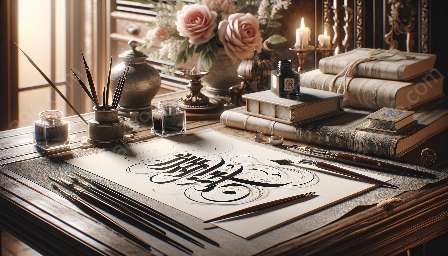If you are passionate about calligraphy and want to master this art, then you must be familiar with the essential tools and materials used in calligraphy. Understanding the importance of these tools and materials is crucial for laying a strong foundation in the basics of calligraphy and achieving precision and finesse in your work.
Let's explore the range of tools and materials used in calligraphy, from traditional to modern, and understand how they contribute to the art of calligraphy.
The Basics of Calligraphy
Before we delve into the tools and materials, it is important to understand the basics of calligraphy. Calligraphy is the art of beautiful writing, often characterized by decorative and elegant lettering. It involves the use of specific techniques to create visually appealing and well-structured letters and compositions.
The basics of calligraphy include mastering various styles and scripts, understanding the principles of letterform and spacing, and learning the proper hand movements and posture required for precise and graceful penmanship. These fundamentals form the backbone of calligraphy and are essential for anyone aspiring to excel in this art form.
Traditional Tools and Materials
Traditional calligraphy relies on a set of specialized tools and materials that have been used for centuries to create exquisite lettering and designs. These traditional tools include:
- Nibs and Penholders: Calligraphy nibs are the metal tips that are attached to penholders. They come in various sizes and shapes, each designed for a specific style or script. The penholder provides a comfortable grip and control over the nib, allowing the calligrapher to create precise and fluid strokes.
- Ink: High-quality calligraphy ink is essential for creating rich and vibrant lettering. Traditional inks are usually made from natural pigments and come in a range of colors to suit different styles and preferences. The viscosity and flow of the ink greatly impact the final result, making it a crucial element in calligraphy.
- Parchment or Paper: The surface on which calligraphy is created plays a significant role in the overall appearance of the work. Parchment or smooth, high-quality paper allows the ink to flow smoothly and prevents feathering or bleeding, resulting in crisp and well-defined lettering.
Modern Tools and Materials
While traditional tools continue to hold their significance, modern calligraphers also have access to a range of innovative tools and materials that enhance their practice and creativity. These modern tools include:
- Brush Pens: Brush pens offer the convenience of a pen with the flexibility and expressiveness of a brush. They come in various tip sizes and can mimic the effects of traditional brush calligraphy, allowing for smooth transitions and dynamic strokes.
- Colored Inks and Markers: The availability of a wide range of colored inks and markers provides calligraphers with endless possibilities for creating vibrant and personalized compositions. These inks offer versatility in blending, shading, and layering, adding depth and dimension to calligraphic designs.
- Digitization Tools: In the digital age, calligraphy has experienced a transformation with the use of digitization tools such as graphic tablets and stylus pens. These tools enable calligraphers to create and refine their work digitally, opening new avenues for experimentation and collaboration.
Mastering Calligraphy with Tools and Materials
Understanding and mastering the use of tools and materials in calligraphy is an ongoing process that directly impacts the quality and style of your work. By experimenting with different tools, exploring various materials, and honing your techniques, you can elevate your calligraphy skills and infuse your personal creativity into every piece.
Whether you prefer the timeless appeal of traditional tools or embrace the versatility of modern materials, the key lies in understanding how each tool and material contributes to the art of calligraphy. With dedication and practice, you can harness the potential of these tools and materials to create captivating and expressive calligraphic pieces that resonate with viewers.

